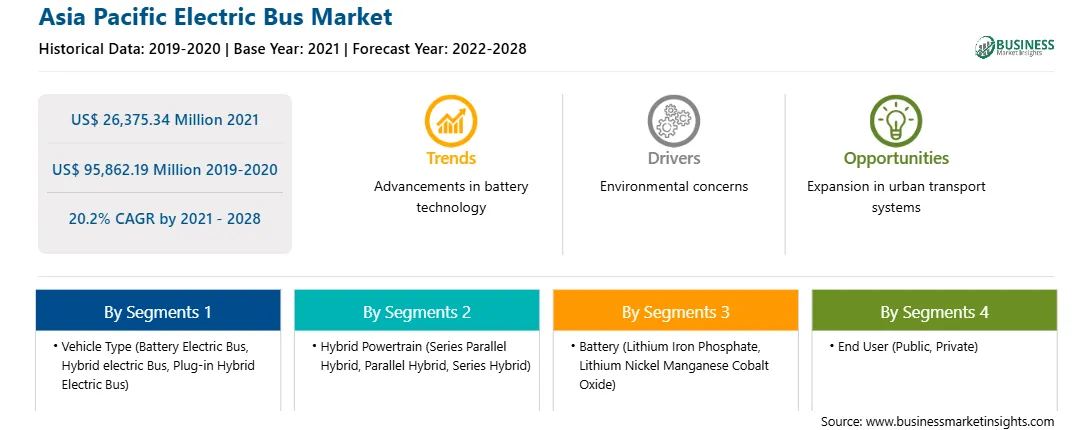亚太地区电动客车市场预测至 2028 年 – COVID-19 影响和区域分析 – 按车辆类型(电池电动客车、混合动力电动客车和插电式混合动力电动客车)、混合动力总成(串并联混合动力、并联混合动力)混合动力和串联混合动力)、电池[磷酸铁锂 (LFP) 和镍锰钴酸锂 (NMC)] 和最终用户(公共和私人)
No. of Pages: 125 | Report Code: BMIRE00025535 | Category: Automotive and Transportation
No. of Pages: 125 | Report Code: BMIRE00025535 | Category: Automotive and Transportation
由于仪表、驱动技术的进步,自主和半自主交通系统已经出现和传感技术。光探测和测距 (LiDAR)、里程表、全球定位系统 (GPS) 和计算机辅助视觉都是让自动驾驶公交车感知环境的进步。由于先进的技术(更可预测的运输时间)和较低的燃料、劳动力和维护成本,自动驾驶在电动公交车行业受到欢迎。原始设备制造商 (OEM) 正在拥抱自动驾驶并创建自动公交车。例如,第一辆全尺寸自动驾驶城市电动公交车已抵达该地区。城市很快将成为电动和自动驾驶巴士的所在地。与此同时,跨国公司华为修建了一条4公里长的自动驾驶巴士测试跑道。因此,自主和半自主交通系统的出现预计将在不久的将来推动整个地区的电动公交车市场。
借助新功能和技术,供应商可以吸引新客户并扩大其在新兴市场的足迹。这一因素可能会推动亚太地区电动巴士市场。 亚太地区电动巴士市场预计在预测期内将以良好的复合年增长率增长。
< p>
亚太地区电动客车市场根据车型、混合动力系统、电池、最终用户和国家/地区进行细分。根据车型,市场分为纯电动客车、混合动力客车和插电式混合动力客车。纯电动客车细分市场在2021年占据主导地位。根据混合动力总成,市场分为串并联混合动力、并联混合动力和串联混合动力。并联混合动力细分市场在2021年占据主导地位。根据电池,市场分为磷酸铁锂(LIP)和镍锰钴酸锂(NMC)。磷酸铁锂 (LIP) 细分市场在 2021 年占据主导地位。根据最终用户,市场分为公共市场和私人市场。公共细分市场在 2021 年占据主导地位。根据国家/地区,亚太地区电动客车市场分为中国、印度、日本、韩国、澳大利亚和亚太地区其他地区。 2021 年,中国在市场上占据主导地位。
AB 沃尔沃;比亚迪有限公司; CAF 集团(Solaris 巴士和长途汽车);戴姆勒股份公司;金龙联合汽车工业有限公司; NFI集团;深圳市五洲龙汽车有限公司;和 Van Hool NV 是亚太地区电动巴士市场的领先公司之一。
Strategic insights for Asia Pacific Electric Bus involve closely monitoring industry trends, consumer behaviours, and competitor actions to identify opportunities for growth. By leveraging data analytics, businesses can anticipate market shifts and make informed decisions that align with evolving customer needs. Understanding these dynamics helps companies adjust their strategies proactively, enhance customer engagement, and strengthen their competitive edge. Building strong relationships with stakeholders and staying agile in response to changes ensures long-term success in any market.

| Report Attribute | Details |
|---|---|
| Market size in 2021 | US$ 26,375.34 Million |
| Market Size by 2028 | US$ 95,862.19 Million |
| Global CAGR (2021 - 2028) | 20.2% |
| Historical Data | 2019-2020 |
| Forecast period | 2022-2028 |
| Segments Covered |
By 车辆类型
|
| Regions and Countries Covered | 亚太地区
|
| Market leaders and key company profiles |
The regional scope of Asia Pacific Electric Bus refers to the geographical area in which a business operates and competes. Understanding regional nuances, such as local consumer preferences, economic conditions, and regulatory environments, is crucial for tailoring strategies to specific markets. Businesses can expand their reach by identifying underserved regions or adapting their offerings to meet regional demands. A clear regional focus allows for more effective resource allocation, targeted marketing, and better positioning against local competitors, ultimately driving growth in those specific areas.

The Asia Pacific Electric Bus Market is valued at US$ 26,375.34 Million in 2021, it is projected to reach US$ 95,862.19 Million by 2028.
As per our report Asia Pacific Electric Bus Market, the market size is valued at US$ 26,375.34 Million in 2021, projecting it to reach US$ 95,862.19 Million by 2028. This translates to a CAGR of approximately 20.2% during the forecast period.
The Asia Pacific Electric Bus Market report typically cover these key segments-
The historic period, base year, and forecast period can vary slightly depending on the specific market research report. However, for the Asia Pacific Electric Bus Market report:
The Asia Pacific Electric Bus Market is populated by several key players, each contributing to its growth and innovation. Some of the major players include:
The Asia Pacific Electric Bus Market report is valuable for diverse stakeholders, including:
Essentially, anyone involved in or considering involvement in the Asia Pacific Electric Bus Market value chain can benefit from the information contained in a comprehensive market report.